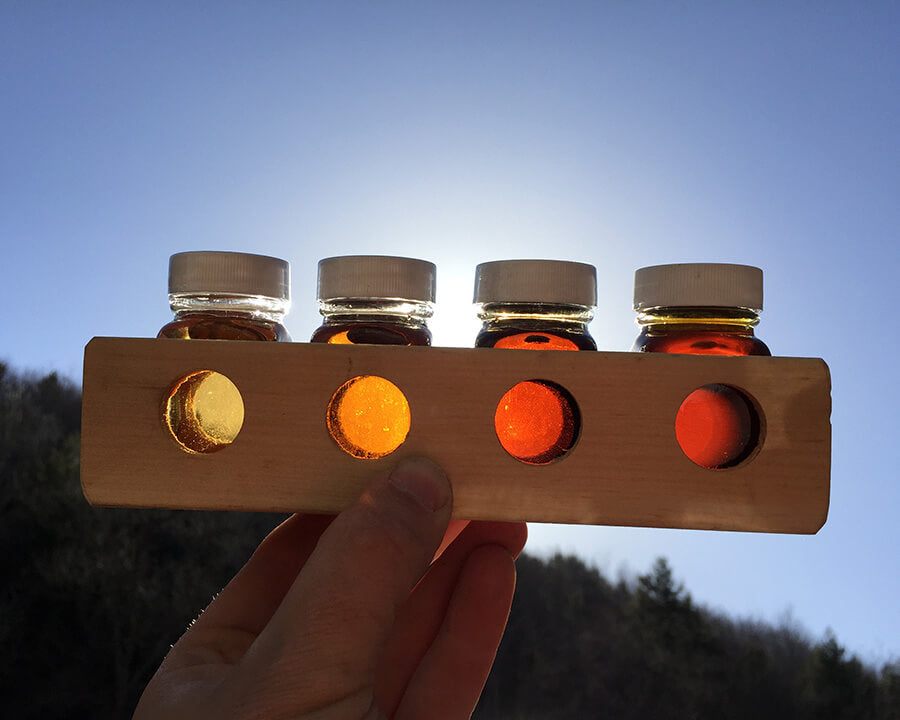
The Ultimate Guide to Maple Syrup
We all love maple syrup - it’s an all-natural sweetener made from maple tree sap boiled over a wood-fired evaporator. We mash it into sweet potatoes, drizzle it over yogurt, marinate meats or tempeh, spoon it into smoothies, and whip it into baked goods. Ah, luscious maple syrup has a smokey, caramel smell with woody notes of vanilla and English toffee. One sniff and you’re transported to a cozy log cabin in the woods overlooking a winter white snowbank. Inside, you sit by the fireplace and sip tea, comfy in some soft slippers; in the kitchen fluffy pancakes sizzle on a hot grill while a tall jar of maple syrup awaits your grasp.
As maple syrup lovers, we should understand everything about this liquid gold. But most of us don’t know about the grades of this amazing sweet treat and what makes them different. In this article, we want to explain and demystify maple syrup grades.
Let’s dive in.
What is the difference between Grade A and Grade B organic maple syrup?
In the past, grade A was often considered the preferred grade by consumers because of its light maple flavor. Grade B was typically produced later in the season and had a darker, grittier color, thicker viscosity, increased minerals, and a more robust maple flavor.

Many professional chefs and home cooks still reference grade A and B in recipes, but this grading system was officially changed in 2015. Technically you can no longer buy grade B maple syrup. Grade B has been replaced with Grade A Very Dark (STRONG taste).

The USDA adapted the grading system based on proposed changes from the International Maple Syrup Institute (IMSI). Previously each state had their own way of grading maple syrup - some would call it ‘Fancy’, or ‘Light’, or ‘Medium Amber’ or ‘Extra Light’ etc etc. It was very confusing to consumers. Having it all conform to one system helps everyone understand what they prefer and how to ask for it!

Another reason maple grading was changed was that consumers perceived or assumed that grade B was an inferior quality syrup. In turn, many would seek out grade A dark when there was no such thing. Or they would expect a lower price point for grade B dark.
In actuality, grade B is equal in quality to grade A. Yet the naming didn’t convey that message. To avoid confusion, the industry reclassified all maple syrups as grade A.

These are the 4 simple grades that are now used globally:
Grade A - GOLDEN (delicate taste) - formerly known as ‘Grade A Light’
Grade A - AMBER (rich taste) - formerly known as ‘Grade A Medium’
Grade A - DARK (robust taste) - formerly known as ‘Grade A Dark’
Grade A - VERY DARK (strong taste) - formerly known as ‘Grade B’
They are all grade A, but each has a different color and taste profile. You can think of it the way we think of red wine: some prefer a Merlot, while others like a Cabernet Sauvignon - but both are red wines!
There has been a shift in customer preference over the years. Now at least 95% of our customers prefer DARK or VERY DARK syrup. Within the Tree Juice team, Jake loves AMBER syrup while Ryan and Rae (who have superior taste buds! LOL!) can't get enough of the VERY DARK syrup. This year we made some of the darkest maple syrup we have ever made. It has an amazing English Toffee taste!
What is grade A?
According to the USDA, U.S. Grade A is the quality of maple syrup that:
- Not more than 68.9% solids content by weight (Brix);
- Has good uniform color;
- Has good flavor and odor, and intensity of flavor (maple taste) normally associated with the color class;
- Is free from off-flavors and odors considered as damage;
- Is free from cloudiness, turbidity, sediment, and is clean;
- No deviants for damage shall be allowed in Grade A.
Does maple syrup have health benefits?
Pure maple syrup has more nutritional value than most sweeteners and has one of the lowest calorie levels. It's got several minerals including potassium, calcium, manganese, phosphorus, iron, and selenium. In this study you can see that maple syrup has up to 24 different antioxidants, which is like unleashing an army inside your body to heal free radical damage and inflammation. Read more in our article: Maple syrup benefits.
Here’s a more in-depth look at the nutrition information of pure maple syrup from the International Maple Syrup Institute.
Is all this maple syrup talk making you crave the sweet stuff? We got you. Our Pure Maple Syrup comes from a nearly 100-year-old farm in New York. Tree Juice Maple Syrup is made in the Catskill Mountains of New York, and the Fairbairn family has owned and operated this 100+ acre farm since the 1930s.

Around 8,000 maple trees are tapped each year. The sap is then boiled over a traditional wood-fired evaporator which turns it into our sweet stuff! This delicious maple syrup is All Natural, Non-GMO, Vegan, Gluten-Free, Vegetarian, and Paleo. Get yours today!

